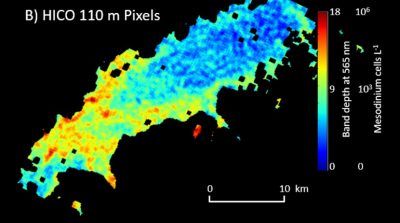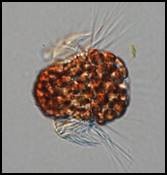 For over 30 years, satellite ocean color imagers have contributed to our knowledge and understanding of the world’s oceans. Empirical algorithms yield global climatologies of primary production which are linked to particulate flux in the water column, thereby tracing the fate of the anthropogenically derived CO2 in the environment to its primary sink in the oceans. Some estimates suggest that twenty percent of the oceanic uptake of anthropogenic CO2 occurs in coastal and marginal seas, where traditional empirical methods are stymied by optical complexity and a lack of data. The ability of current remote sensing approaches to accurately measure bio-optical pigments and primary productivity in the coastal zone will help not only to improve carbon budgets there, but also will contribute to the parameterization of ecological models used in the investigation of estuarine eutrophication-induced hypoxia. Satellite ocean color retrieval of even the most basic bio-optical property, chlorophyll concentration, has remained elusive in LIS, which is characterized by water masses containing high chromophoric dissolved material concentrations and a bi-annual phytoplankton bloom, as well as annual eutrophication-induced hypoxia at its western end. This research uses in situ optical measurements from LIS to optimize algorithms for remote sensing of surface chlorophyll, spectral phytoplankton and dissolved absorption, and diffuse attenuation from ocean color satellite imagery.
For over 30 years, satellite ocean color imagers have contributed to our knowledge and understanding of the world’s oceans. Empirical algorithms yield global climatologies of primary production which are linked to particulate flux in the water column, thereby tracing the fate of the anthropogenically derived CO2 in the environment to its primary sink in the oceans. Some estimates suggest that twenty percent of the oceanic uptake of anthropogenic CO2 occurs in coastal and marginal seas, where traditional empirical methods are stymied by optical complexity and a lack of data. The ability of current remote sensing approaches to accurately measure bio-optical pigments and primary productivity in the coastal zone will help not only to improve carbon budgets there, but also will contribute to the parameterization of ecological models used in the investigation of estuarine eutrophication-induced hypoxia. Satellite ocean color retrieval of even the most basic bio-optical property, chlorophyll concentration, has remained elusive in LIS, which is characterized by water masses containing high chromophoric dissolved material concentrations and a bi-annual phytoplankton bloom, as well as annual eutrophication-induced hypoxia at its western end. This research uses in situ optical measurements from LIS to optimize algorithms for remote sensing of surface chlorophyll, spectral phytoplankton and dissolved absorption, and diffuse attenuation from ocean color satellite imagery.
 Red water has been reported by other observers on occasion in Long Island Sound. But although Mesodinium was present in over 80% of all samples examined in more than 10 years of monthly plankton monitoring, no sample ever exceeded 2.6 x 104 cells l-1. In Fall of 2012, UCONN personnel servicing a moored array in the western Sound observed and sampled red water in western Long Island Sound (40.9°N 73.6°W). Microscopy and DNA sequencing confirmed that the bloom was due to Mesodinium, and we subsequently reported on our efforts to document the bloom using satellite imagery from the HICO hyperspectral sensor using a unique yellow fluorescence signature unique to the accessory pigment phycoerithrin.
Red water has been reported by other observers on occasion in Long Island Sound. But although Mesodinium was present in over 80% of all samples examined in more than 10 years of monthly plankton monitoring, no sample ever exceeded 2.6 x 104 cells l-1. In Fall of 2012, UCONN personnel servicing a moored array in the western Sound observed and sampled red water in western Long Island Sound (40.9°N 73.6°W). Microscopy and DNA sequencing confirmed that the bloom was due to Mesodinium, and we subsequently reported on our efforts to document the bloom using satellite imagery from the HICO hyperspectral sensor using a unique yellow fluorescence signature unique to the accessory pigment phycoerithrin.